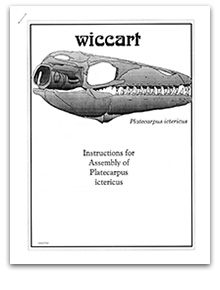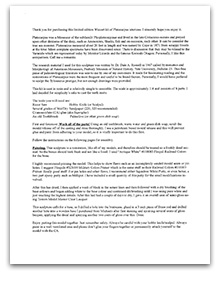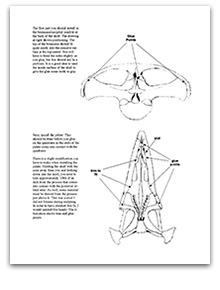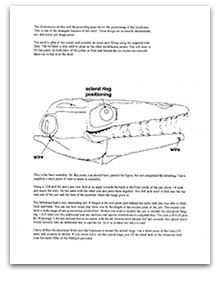Platecarpus ictericus skull
L 165, H 80, W 80 (mm)

Finished model by the original sculptor Steve Harvey
This is an impressive model. By Wiccart standards it's large and parts are robust with a smooth, tactile, bone feel. This is the model that the sculptor Steve Harvey considered his best work.
It's not without problems however. It suffers typical bubble and pouring artifacts and requires a fair amount of cleanup. The instructions state that some Milliput 2-part epoxy clay was supplied with the kit for filling and repair work but this was missing from my kit. Further, the palate needs some tricky modification to fit during assembly, also requiring Milliput as a gap filler.
The model is cast in an off-white resin, although the teeth are a slightly different yellower resin as they were cast "in-situ" using a two-step method. This means teeth were poured and set in an open mold first and the mold later closed and fresh resin poured over the top to complete the casting. This two-step method is often used for parts with difficult details like protruding teeth. Most Wiccart kits have all sepatate teeth which complicates assembly. Here they are very cleanly cast without any seam lines or flash artifacts. It states in the instructions that each model took two days to make using this two-step procedure.
Besides an additional row of teeth on the palate inside the skull, Platecarpus has an unusual hinged jaw that could flex outward at the mid-point. The kit had a replacement option where, for an additional fee, Wiccart would send extra parts to aid separation of the jaw at the hinge point.
I obtained an original copy of this kit in 2010 from SiaoMouse, a collector from Singapore. It was unbuilt and as-new, number 5 in an edition of 25 produced. I won't build the model but recast the parts and work on a copy to preserve the original as much as possible.
Kit
Comprises:
- 8 separate cast parts (scleral rings cast together)
- 4 pages of instructions
- No photo of finished model
- Signed certificate of authenticity (opposite)
- Milliput 2-part epoxy clay (missing)
- Wire (missing)
- No box or custom packaging
- No mounting hardware (wood base available on request)
Parts
Parts images kindly provided by SiaoMouse (Singapore)
Instructions
Press
Prehistoric Times
No sooner do we review Wiccart's new
Styracosaurus skull last issue than we are treated with owner and sculptor,
Steve Harvey's latest skull model of the mosasaur, Platecarpus ictericus. So,
Steve has been a busy boy and we're glad he has. Mosasaurs were huge sea-going
reptiles of the late Cretaceous period that roamed the inland seas of North
America and Europe. An off-shoot of the monitor lizard family, the mosasaurs
evolved flippers and breathing adaptations that made them completely suitable
for a life at sea. Many specimens have been found in the chalk deposits of
Kansas. Science knows of 16 different genera of mosasaurs and several have more
than one species. The mosasaurs ranged in length from 14ft. to 35ft. and more.
They had long, flat bodies and probably longs fins running their entire length
on top and bottom. There is strong evidence that they ate ammonites, soft
tentacled creatures who lived inside coiled shells. Evidence for this comes
from fossilized shells scored by V-shaped tooth marks as on mosasaurs. The
shells were bitten dozens of times from different angles in an attempt to crack
them open to get at their chewy center.
Actually I was foretold of this sea-dragon's arrival to PT weeks prior so I immediately commenced doing my homework, except I cheated. Utilizing the modern miracle of E-mail, I employed the help of two noted paleontological scientists, Dr. George Callison of Dinamation and Dr. Gordon Bell Jr. of the Museum of Geology/South Dakota School of Mines & Technology. (I originally asked Dr. Phil Currie and Jim Kirkland, who both claimed to not be experts and sent me to these and other sources). First let me thank all of these gentlemen for taking the time to give me their invaluable aid. Dr. Bell told me something very interesting right off the bat and that is that he and other mosasaur experts no longer support P. ictericus as a valid taxon. P. ictericus, P. coryphaeus, and P. tympaniticus are one in the same with the name tympaniticus having priority. He told me that this is not yet in scientific literature but will be when the Marine Reptile Symposium volume (Academic Press) hits the street soon. Both men gave me a number of important guidelines to go by when determining the scientific accuracy of Wiccart's new skull kit. It was also recommended to me to use Dale Russell's book, Systematics and Morphology of American Mosasaurs. Steve Harvey used this reference too when creating this model. From the number of teeth to various proportions and from special features to general shapes this resin kit looks extremely accurate and really great.
Wiccart's Platecarpus kit is cast in resin in 1:4 scale and consists of 8 parts. This is not a model to give to little Johnny to build. In fact, this (is) not exactly an ideal model to give to an adult to build if they haven't had a certain amount of resin model building experience. If you aren't a stranger to resin kits than this is a fine model that with a bit of part cleaning, refitting and patience you will build within a reasonable amount of time. (I took the better part of an evening cleaning up the parts and completely built the kit the next morning, but lets face it, I've been doing this for a decade.) The problem with this and all skeletal kits is that there is very little room where parts touch each other making solid connections challenging. In reality, many bones don't touch each other as they are held together by cartilage, muscles, tendons, etc. With a model, they do have to touch to hold everything together and the contact points can be very small. Steve supplies wire to be installed with a drill for pinning especially tough connections. The end result is well worth the effort. I used everything from wire snips, emery boards, a metal file, sandpaper and my X-Acto knife to clean off excess resin and seams. This was not difficult but somewhat time consuming. Steve includes a three page instruction sheet that even discusses tools needed, info on the animal and painting tips. We are instructed to start off by gluing the braincase to what is called the occipital condyle. This went without a hitch for me. Next you install the palate into the upper mouth. Platecarpus has an inner double row of teeth near the back of its mouth which is very interesting. Steve admits in the instructions that he made an error when sculpting the two palate pieces and one needs to be trimmed considerably to fit. He says in order to have checked this fit he would have needed five hands. At least he made it too big and not too small but you must be very careful to not cut off too much yourself and to cut at the correct angles to save unnecessary filling later.
think that the next and final
steps of assembly are not covered very well in the instruction sheet. They
involve attaching these strange 'ear bones' called Quadrates and situating the
jaw under the top half of the skull. There is an illustration but I certainly
would have appreciated Steve sitting next to me for help with all of these
steps. This involved a lot of trial and error. Scleral rings (donut shaped eye
bones) are supplied but as Steve says these are optional and I opted not to
attach them in the model I completed that you can see in the photo. Steve did
quite a bit of excellent, detailed sculpting on this mosasaur. The teeth,
although two on my copy were incomplete due to air bubbles, look absolutely
real. Hopefully my photo of my completed kit will show justice to this
incredibly well done model kit. I merely wanted to prepare you for what may be
less than an easy build.
— Issue #22, January–February 1996
Reference
The sculpture was inspired by and based on detailed drawings from Peabody Museum of Natural History Bulletin Number 23: "Systematics and Morphology of American Mosasaurs" by Dale A. Russell, 1967. A substantial work of 237 pages with 99 figures, 7 charts, 2 plates, appendices, and index, it's available now as a print-on-demand facsimile reprint.
Request
If you have additional information, resources or images
I am very keen to hear from you. Please contact me.





